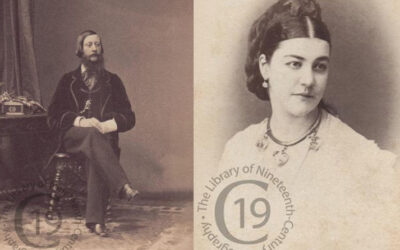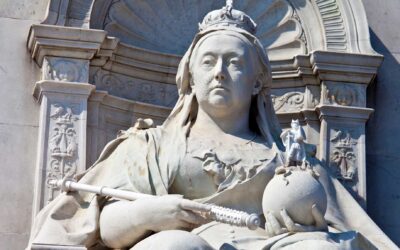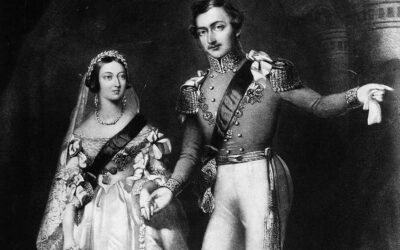Charlotte von Siebold:
The Pioneering German midwife who delivered the future Queen Victoria
“Her success, not only in the obstetric art, but in the different complaints more particularly incidental to her own sex, has established her reputation on the Continent.”
The Birth of a Future Queen
At 4.15 in the morning of 24 May 1819 a baby girl was born, the only living, legitimate child of a son of the incumbent King George III. The baby’s father – King George’s fourth son, Edward, Duke of Kent, – had for several years been forced by escalating debts to live abroad, but he was determined that this important royal baby, a future heir to the throne, should be a ‘Briton-born’.
With this in mind, the duke had raced back to England from Amorbach in Germany at the end of April 1819, in order to ensure the child’s arrival in newly decorated apartments provided for him and his wife at Kensington Palace.
The baby’s mother, Princess Victoria of Saxe-Coburg-Saalfeld had gone against the convention of the day, by bringing her own midwife with her from Germany. Charlotte von Siebold had delivered the strong and lusty baby, named Alexandrina Victoria, smoothly and efficiently after a relatively short six–hour labour.
The Choice of a German Midwife
During the birth, two royal doctors, as per royal tradition, had been on hand, should their services be required. Dr David Daniel Davis, a Welsh physician who had written a medical textbook on obstetrics had been obstetrician to a royal maternity charity of which the Duke of Kent was patron. Dr Wilson, who was there to assist, was an ex naval doctor late of HM frigate Hussar, who had been appointed the Duke of Kent’s personal physician. Wilson had looked after the Duchess throughout her pregnancy and had travelled over from Amorbach with the Kents.
The Duke of Kent was no doubt mindful of the terrible trauma undergone by his niece Princess Charlotte, the Prince Regent’s heir, the previous year. She had died after giving birth to a stillborn son after a protracted and agonizing labour, her pregnancy having been mismanaged by male royal doctors. Nevertheless, he insisted on having a top medical man present at his wife’s delivery. This, despite the fact that his sister-in-law Adelaide, the Duchess of Clarence, had lost her first baby in March 1819 after being attended during childbirth by a conventional male physician.
The Duchess of Kent, may as a result, have insisted on following the advice of her mother Augusta, Duchess of Saxe-Coburg-Saalfeld that the actual delivery of her baby should be entrusted to a female midwife. They had chosen Charlotte von Siebold, who for the last four years had been making a name for herself in the German duchies of Hesse and Coburg, as a pioneering obstetrician and gynaecologist.
‘The Excellent Mademoiselle Siebold’
At the time of the future Queen Victoria’s birth, false rumours had circulated that the delivery had been difficult and that Davis had taken over from Siebold. But this is not so. Siebold emerged from the delivery room to announce the birth of a girl to the gathered dignitaries with considerable delight, adding in her thick German accent: ‘Verr nice beebee. No big but full. You know, leetle bone, mush fat.’
The Duke of Kent was the proudest of proud fathers, declaring his robust little girl to be ‘as plump as a partridge’ and ‘truly a model of strength and beauty combined’ . In a letter to his mother in law Augusta, the Dowager Duchess of Saxe-Coburg-Saalfeld, he had nothing but praise for the ‘excellent Mademoiselle Siebold’ who could not have shown ‘more activity, more zeal and more knowledge than she has done’.
Siebold herself was captivated by baby Alexandrina. She pronounced her a ‘dear little love’ on her return to Coburg at the beginning of August when she visited the Duchess of Saxe-Coburg-Saalfeld to fill her in on all the details. Within a couple of weeks, she would be bringing the baby’s future husband, Prince Albert, into the world.
But who was Charlotte von Siebold and where did she learn her midwifery skills? The history books tell us very little beyond her attendance at the births of Victoria and Albert within three months of each other in 1819. But she was in fact born into a distinguished family of pioneering German obstetricians.
A Pioneering Family of German Obstetricians
Mariane Theodore Charlotte Heiland, was born in Heiligenstadt, in Thuringia in September 1788 and baptised on the 12th of that month. (Some early German sources give her date of birth as 14 October 1792 but it has not been possible to unravel this discrepancy). She seems to have been best known by her third Christian name of Charlotte and was the daughter of another female medical pioneer doctor and obstetrician: Regina Josepha Heiland née Henning (1771–1849). After being widowed in 1793 Charlotte’s mother (better known by her second name Josepha) married Johann Theodore Damian von Siebold, (1768-1828) who came from a well-known family of German physicians, and who formally adopted Josepha’s two daughters. As Frau von Siebold, Josepha took up training in obstetrics in 1802, attending lectures in Würzburg given by her brother-in-law the gynaecologist Adam Elias von Siebold (1775-1828; son of Carl Caspar von Siebold 1736-1807 another obstetrician who also lectured there till his death).
Adam was professor of anatomy, surgery and midwifery and highly sympathetic to the needs of women in childbirth. When delivering babies, he always held to his mantra:
Peace and silence, time and patience, respect for nature and the woman in childbirth, and the art of waiting, when Mother Nature rules.
Stille und Ruhe, Zeit und Geduld, Achtung der Natur und dem gebärenden Weibe, und der Kunst Achtung, wenn ihre Hülfe die Natur gebietet.
In 1807 Josepha obtained her license to practice from the Grand Ducal Medical College in Darmstadt, which also, uniquely, licensed her to administer smallpox vaccinations, indicating the extent to which Germany led the way in women’s medical training. In 1815, Josepha received an honorary degree in obstetrics from Giessen University in Hesse, the first woman to do so. She continued in practice as a midwife and vaccinating physician until her death in Darmstadt in 1849.
Following in Her Mother’s Footsteps
It is no surprise that the young Charlotte von Siebold followed the distinguished medical tradition of mother and her stepfather’s family. In 1805 aged 17 she began studying anatomy, physiology and obstetrics under her parents’ guidance and in 1811 went to Göttingen University to attend private lectures by the then leading obstetricians Johann Friedrich Osiander and Konrad Johann Langenbeck.
In 1814 Charlotte received her licence to practice obstetrics from the Grand Ducal Medical College in Darmstadt. A year later, when her mother was seriously injured in a carriage accident, she took over her obstetrics clinic. Such were Charlotte’s skills and her growing reputation that in 1817 she was awarded a doctorate in obstetrics in front of an enthusiastic audience at Giessen University, on the basis of her 23-page research paper : ‘Extra-uterine Pregnancy, and Especially a Case of Abdominal Pregnancy’ [‘Über die Schwangerschaft außerhalb der Gebärmütter und über Bauchhöhlenschwangerschaft insbesondere’]. Her paper described the course of an abnormal, abdominal pregnancy, the futile attempts at surgical intervention and the post mortem examination. It also argued for the restricted use of forceps in delivery – prompting Charlotte’s former tutor, Osiander to write dismissively on his copy of her thesis that ‘pregnancy became women better than writing about that condition’.
Pioneering Obstetrics Work in Hesse & Saxe-Coburg
By now Charlotte was working in joint practice with her parents at their obstetrics clinic in Darmstadt, the capital of the German Grand Duchy of Hesse and by Rhine. Her skills rapidly gained her a wide reputation in Hesse and in nearby Saxe-Coburg, not just as a midwife but more generally as a gynaecologist.
It is clear that by 1818 she had become a fashionable obstetrician – or accoucheuse – the euphemistic French term then in popular usage among the aristocracy. Her first important delivery appears to be that of Prince Albert’s older brother Ernest on 21 June 1818 to Luise, the 17-year old wife of Duke Ernest I of Saxe-Coburg-Saalfeld. On the strength of this, Charlotte von Siebold appears to have been recommended as accoucheuse to Ernest’s sister, Victoire when she became pregnant by her second husband, the Duke of Kent that same year.
The Novelty of a ‘Female Doctor’
The social cachet of successfully delivering the heir to the throne of Saxe-Coburg-Saalfeld (from 1826 Saxe-Coburg and Gotha) soon brought requests from other German relatives. In May of 1819 Charlotte von Siebold was called to attend the confinement in Berlin of Frederica, Duchess of Cumberland (the German-born wife of Queen Victoria’s uncle Ernest Augustus). The labour and delivery had proved to be extremely dangerous and, so the press later related, it was ‘only by the greatest skill and pains that Dr Von Siebold succeeded in saving the mother and infant’ – a son, Prince George. When he was born on 27 May, the baby had ‘at first supposed to be still-born, but proper means being resorted to, he soon gave signs of life’. According to the Ladies Monthly Repository the mother and child were ‘said to owe their preservation, under God, to the skill and care of Dr. Siebold, her Highness’s accoucheur.’
Thus, when Charlotte von Siebold successfully delivered the new British princess and future Queen Victoria in May 1819, the press was fascinated by accounts of this novelty – ‘A Female Doctor’, ‘daughter of Dr von Siebold of Darmstadt and Madame von Siebold a celebrated accoucheuse in Germany’:
‘However singular it may appear in this or in any other country, this lady actually attended the various courses of medical lectures at Gottingen … Since that time her success, not only in the obstetric art, but in the different complaints more particularly incidental to her own sex, has established her reputation on the Continent, and has led to the choice made of her on the present occasion, a choice which the event has so well justified.’
The Birth of Prince Albert
Within days of her return to Coburg in August 1819,Charlotte again proved her worth when on 26 August 1819 she brought baby Prince Albert into the world at the family’s summer residence, The Rosenau.
After only a three- hour labour ‘at 6 the little one shrieked his way into the world, and looked about him with a pair of great black eyes [they were in fact blue], as lively as a squirrel,’ wrote the baby’s proud grandmother, the Dowager Duchess Augusta, who already had her eye on the prize. Little Albert was perfect and would be ‘the pendant to his pretty cousin’, she wrote. ‘How pretty the little Mayflower [Victoria] will be, when I manage to see her in a year! Siebold cannot say often enough what a lovely little darling she is.’
Charlotte von Siebold’s Career after 1819
In the years that followed Charlotte von Siebold continued with her midwifery and gynaecological practice. In 1829 she married Andreas August Heidenreich (1801-80), a Staff Surgeon at the military hospital in Darmstadt and thereafter practiced as Frau Dr Heidenreich von Siebold. The couple had no children and Charlotte continued with her work: she taught obstetrics and raised money for a charity hospital in Darmstadt and continued to practice with her mother Josepha. Twenty-four years after the birth of Prince Albert, she apparently ‘still had a flourishing practice among Continental royalties’, but so far I have been unable to ascertain which other royal or aristocratic babies she delivered.
But her gynaecological work was not confined to the rich and titled classes, Charlotte von Siebold was especially concerned with better state support for poor and working pregnant women. She investigated the deplorable conditions in which they gave birth in rural areas and was shocked to discover women in the countryside who did not even have their own bed and gave birth lying on the bare earth. In addition, Charlotte believed that mothers needed tuition in the care of newborn babies, and that the lack of knowledge left much to be desired among the rich, as well as among the poor.
The Heidenreich-von Siebold Institute in Darmstadt
In 1845 Charlotte von Siebold reported on her findings to the Grand Duke of Hesse, proposing the establishment of a state maternity hospital. That same year, the Heidenreich-von Sieboldsche Stiftung zur Unterstützung von Armen Wöchnerinnen – an obstetrics institute for poor women in childbirth was opened under her direction. When Queen Victoria and Prince Albert visited Mainz in Germany that year, Siebold was presented to them and they became financial supporters and patrons of her new institute.
In 1864, Queen Victoria’s grand daughter, Princess Alice, now married to Prince Louis of Hesse, became patroness of the Heidenreich Stiftung and embraced the interests in nursing mothers and women’s healthcare in childbirth pioneered by its founder Charlotte von Siebold. The Institute closed in 1948 but there is still a Sieboldstrasse in Darmstadt named after this great pioneering woman doctor, gynaecologist and midwife.
In 1849, Grand Duke Louis III of Hesse awarded Charlotte von Siebold the Hessian Order of Merit of Philip the Magnanimous that his father had established in 1840. After her mother Josepha’s death in 1849, Charlotte took over her patients until her own death in Darmstadt on 8 July 1859.
Latest Articles and Media about Queen Victoria, Prince Albert & their times
Mad Lord Adolphus, Lady Susan and Bertie’s Baby
Even Queen Victoria, who privately loved tittle-tattle but never admitted to it, could not resist being drawn into the saga of mad Lord Adolphus Vane-Tempest and his poor wife Susan…
The Curious Tale of Queen Victoria’s dresser
From Windsor Castle to North Dakota – a fascinating tale of pioneer spirit and triumph over adversity by English immigrants.
Prince Albert’s Birth: Is there any truth in the rumours of illegitimacy?
Books in English often do not have very much to say about Albert’s mother, Princess Luise of Saxe-Gotha-Altenburg. Did her husband’s womanising push her into the arms of another man?
Queen Victoria: Pet Names, Titles, Nicknames & Aliases
During her 63 year reign Queen Victoria acquired a wealth of these. Many were complimentary and affectionate, some were ironic or satirical, and others were downright rude…
The Victorian Christmas
The cosy Dickensian Christmas referred to in Queen Victoria’s diary for Christmas Eve 1860, was in great part popularized by Victoria and Albert after their marriage in 1840. During the 21 years that followed they did much to set their own particular stamp on how the festival is celebrated in this country.
Back Home in Dickensland
As children we were fearless. Mean, and muddy, and at times dispiriting it may have been, but the Medway Estuary was our paradise. My own daydreams draw me there still…
Sarah Forbes Bonetta: the Captive African Princess Gifted to Queen Victoria
In its Christmas Special for December 2017 the ITV series Victoria featured the story of Sarah Forbes Bonetta, a captive African princess who was brought to the court of Queen Victoria. She has frequently been described as the Queen’s goddaughter’ but this is not in fact true…
Queen Victoria’s dress sense – or lack of it
Queen Victoria’s dress sense – or rather, lack of it – was a subject that regularly provoked the despair of her courtiers. Despite his best efforts, the court painter, Franz Winterhalter, who painted some of the most fashionable women in Europe, could not disguise Victoria’s slightly provincial air…
Queen Victoria’s Passion for Photography
The 63-year reign of Queen Victoria brought with it much invention and innovation, but nothing has probably been more significant in defining the mental picture we all of have of her and Victorian everyday life than the photograph.





